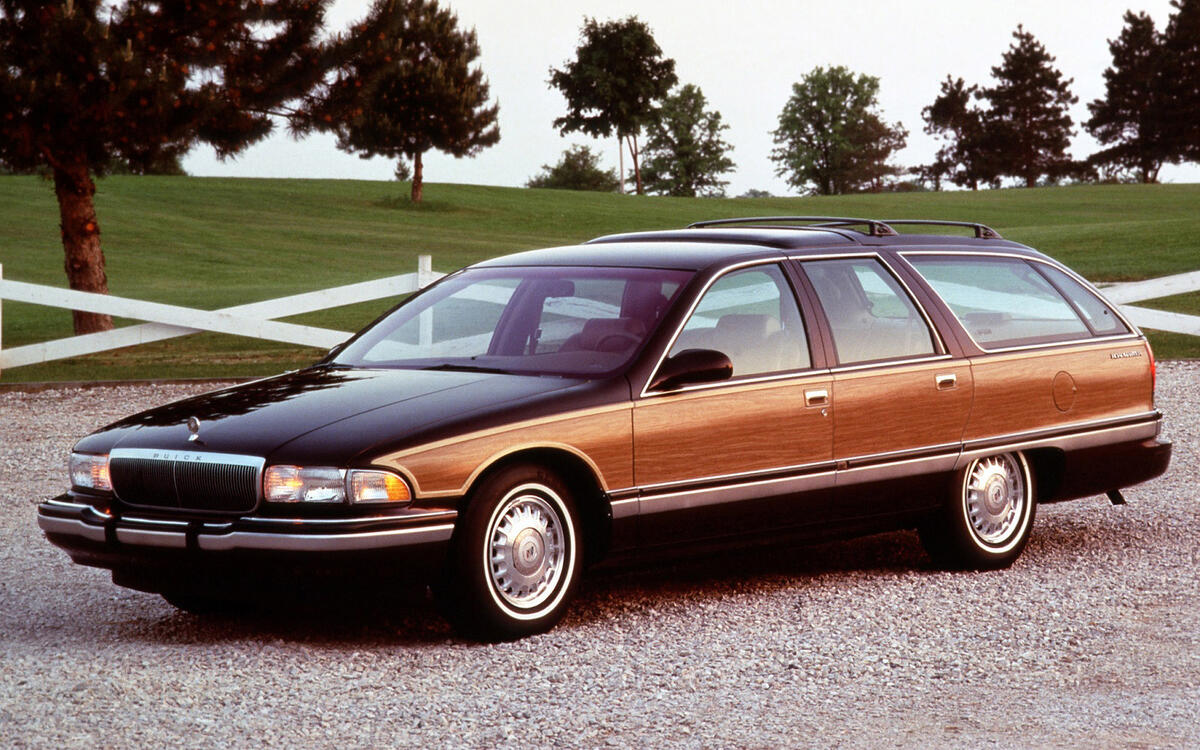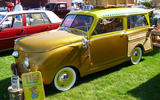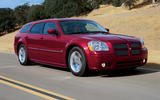 Slide of
Slide of
The station wagon once enjoyed a significant share of the new car market in the US.
Long-roof models came in all shapes and sizes, from utilitarian to family-friendly. The segment became even more diverse as European and Japanese companies bounded into the American market, but it began declining when the minivan rose to prominence in the 1980s. Today, the SUV has all but buried both body styles.
Some predict a full-blown wagon renaissance is around the corner as buyers begin growing weary of SUVs and higher gas prices. It would open a new chapter in the history of the wagon. Until that happens, here are some of the models that have left their mark, for better or worse, on the wagon segment in America:
 Slide of
Slide of
Chevrolet Suburban Carryall (1935)
The modern-day Chevrolet Suburban is one of the largest SUVs sold in the US. The nameplate started life 11 generations ago as one of the first American station wagons with a body made entirely out of steel instead of wood. A frame borrowed from the brand’s half-ton commercial truck helped it associate usability with durability. The original model only had one door on either side and its Stovebolt straight-six engine made 60hp.
 Slide of
Slide of
Plymouth P6 Westchester Suburban (1938)
Every generation of the Chevrolet Suburban has received the ‘light truck’ label due to their truck-derived underpinnings. The wood-bodied Plymouth Westchester Suburban started life with truck genes (1936 model pictured), too, but it was classified as a car in 1938 because it shared its basic chassis with the P6 sedan. It was easier to drive than its Chevrolet-badged rival and more road-trip friendly thanks to a less truck-like ride.
Production totaled 555 examples, a respectable statistic considering America hadn’t fully recovered from the 1937 recession yet.
 Slide of
Slide of
Chrysler Town & Country (1941)
Introduced shortly before the US entered World War II, the Chrysler Town & Country was the first American woody wagon with a roof made of steel instead of wood. Chrysler marketed the model as a luxurious vehicle with space for up to nine passengers. It was aimed at families and hotels who needed to transport guests to and from the nearest train station or airport.
 Slide of
Slide of
Willys Jeep Station Wagon (1946)
As one of the first family-haulers on stilts, the Willys Jeep Station Wagon marked a pivotal point in the history of both the SUV and the station wagon. It originated from Willys’ attempt to turn the go-anywhere Jeep built during World War II into a broader line-up of rugged and hopefully profitable cars. The bet was a successful one and Station Wagon production continued until 1965. (1946 model pictured)
 Slide of
Slide of
Crosley CC Four (1947)
Ohio-based Crosley wanted Americans to think small. The CC Four family of city cars it launched after World War II stood proud with a contemporary design, though the parts under the sheet metal largely came from pre-war models. The wagon, like most of Crosley’s other models at the time, used the 26hp CoBra engine. It was made from copper-brazed sheet metal, not cast iron, which was interesting but wrong. It created an annoying assortment of reliability problems.
Mechanical eccentricity aside, buyer response to a pocket-sized wagon with two doors was tepid because Americans weren’t ready to downsize. Motorists gradually began shifting towards smaller models in the 1970s, but Crosley wasn’t around to capitalize on the change, as it ceased production in 1952.
 Slide of
Slide of
Packard Eight Station Sedan (1948)
Cost-cutting in the automotive industry is nothing new. In the mid-1940s, Packard wanted a slice of the lucrative station wagon segment without developing one from scratch. It found a solution after a brain-storming session with Detroit-based Briggs Manufacturing Company.
Packard plucked Super Eights off its assembly line and sent them to Briggs, where they received a longer roof, a two-piece tailgate plus panels made from ash and maple. The aptly-named Station Sedan straddled the line between the station wagon and sedan segments. Just 3900 examples were manufactured, a figure which suggests Packard’s handiwork didn’t convince buyers in the market for either type of car.
 Slide of
Slide of
Ford Country Squire (first generation, 1950)
The original Ford Country Squire was a true woody. The steel body served as a frame into which assembly line workers inserted mahogany panels. The tailgate was made entirely out of wood. Ford sourced the lumber from forests it owned in the Upper Peninsula of Michigan. It’s an expensive aspect of car-making companies no longer need to invest in, and a dexterous aspect of car-building assembly line workers no longer need to master.
The second-generation Country Squire introduced in 1952 switched to an all-steel body for cost reasons, though it retained decorative wood panels.
 Slide of
Slide of
Chevrolet Nomad (first generation, 1955)
Chevrolet previewed the Nomad wagon with an alluring concept displayed in 1954 during the GM Motorama event, an auto show that drew immense crowds as it traveled across America. The production model unveiled a year later retained the concept’s two-door layout but lost the Corvette front end to fall in line with the then-new second-generation Bel Air. While production ended in 1957, Chevrolet grafted the Nomad emblem onto a four-door wagon. (1955 model pictured)
 Slide of
Slide of
Checker Aerobus (1961)
Checker presented the Aerobus as “the taxi-proven limousine that’s built to be a limousine.” It looked like a stretched Marathon, but the Aerobus was designed as a long-wheelbase model from the ground up with numerous modifications and reinforcements to ensure it didn’t fold in half. Checker offered the Aerobus as a nine-seater with six doors or as a 12-seater with eight doors. Though not as popular as the taxi model, the Aerobus was a reasonably common sight at America’s major airports.
 Slide of
Slide of
Chevrolet Corvair Lakewood (1961)
Positioned at the bottom of Chevrolet’s wagon hierarchy in terms of size and price, the Corvair Lakewood shared its air-cooled flat-six engine with its sedan and coupe siblings. The rear-engined configuration made the model more spacious than its primary rivals because it offered both front and rear storage compartments. Public response was lukewarm, and the 1962 introduction of the front-engined Chevy II wagon drove the final nail in the Lakewood’s coffin. Production ended after only two model years, while the other Corvair body styles lasted until 1969.
 Slide of
Slide of
Studebaker Wagonaire (1963)
The Studebaker Wagonaire sounds like a cross between a Jeep Wagoneer and a Chevrolet Bel Air. It’s neither, and it’s certainly not the sum of their parts. Instead, it was an admirable crack at building a more useful wagon by making the rearmost part of the roof panel retractable, giving the model a pickup-like ability to carry long items. It was clever but it never caught on due largely to the fact that Studebaker never figured out how to make it fully water-tight.
GMC resurrected the design with the 2004 Envoy XUV, which was water-proof but not significantly more successful than the Wagonaire.
 Slide of
Slide of
Oldsmobile Vista Cruiser (first generation, 1964)
No 1960s station wagon offered more family-friendly amenities than the Oldsmobile Vista Cruiser. Sky lights integrated into a raised roof panel let natural light into the cabin while giving the rear occupants a scenic view of what’s above. Youngsters also benefitted from their own sun visors, while Oldsmobile offered a third row of front-facing seats at an extra cost. (1964 model pictured)
 Slide of
Slide of
Ford Pinto (1972)
Ford’s entry-level Pinto surfed a tidal wave of downsizing created, optimistically, to crush imported car brands. For years, Americans sourly remembered the model for its safety issues. The black sheep of the Ford family entered popular culture as an emblem of middle-class suburban life in the 1970s, sending prices of un-charred examples on the rise.
 Slide of
Slide of
Ford LTD Country Squire (seventh generation, 1979)
The final Ford Country Squire shrank considerably, going from an XXL to an XL. It shared its sheet metal and, later, most of its mechanical components with the Crown Victoria, which served as the police car and taxi of choice across America for many decades. The all-new Crown Victoria introduced in time for the 1992 model year retained its predecessor’s body-on-frame architecture but the wagon model went to the great junkyard in the sky.
 Slide of
Slide of
AMC Eagle (1980)
With the Eagle, AMC sought to ally the off-road capacity of an SUV with the handling of a passenger car. In hindsight, the firm’s unprecedented stroke of genius created the modern SUV well before the body style became popular. The humdrum Concord donated its body to the passenger car part of the equation, while AMC sub-division Jeep contributed its vast expertise in the four-wheel drive section.
 Slide of
Slide of
Buick Roadmaster (1991)
The wagon’s irreversible decline became glaringly obvious at the dawn of the 1990s, but Buick stayed the course because it couldn’t figure out how to integrate an SUV into its line-up, let alone a minivan. Often clad with fake wood paneling, the jumbo Roadmaster (218in or 5530mm) looked positively dinosaur-esque when it retired in 1996. Chevrolet’s Caprice wagon got the bullet at the same time, marking the end of the full-size wagon segment in America.
 Slide of
Slide of
Ford Taurus (1999)
The Taurus wagon was a mainstay of the Ford line-up during the 1980s. Sales nose-dived during the 1990s in the wake of new competition from minivans and SUVs, including Ford’s very own Explorer. The Taurus perfectly illustrated the entire segment’s sharp decline.
Product planners inevitably deep-sixed the long-roof model and dropped the Taurus nameplate entirely in 2006. The Five Hundred filled the Taurus’ position while the Freestyle SUV replaced the wagon. Today, Ford’s last wagon on the American market is the Flex. It’s fast approaching its 10th birthday, and our crystal ball predicts it’s not long for this world.
 Slide of
Slide of
Dodge Magnum (2004)
Nearly blotted out of the history book, the original Dodge Magnum took the form of a mammoth coupe. The second-generation model introduced nearly three decades later brought the brand back to the wagon segment after a long hiatus. It almost qualified for the coveted ‘shooting brake’ label thanks to a sloping roof line and rakish D-pillars. The short-lived SRT-8 model packed 425hp from a Hemi V8.
Not as popular as Dodge hoped, the Magnum met its fate in 2008. Europeans knew it as the Chrysler 300C Touring and they could order it with a Mercedes-Benz-sourced 2.7-liter five-cylinder turbodiesel engine not offered on the other side of the pond.
 Slide of
Slide of
Cadillac CTS Sport Wagon (2009)
Cadillac’s renaissance hinged on its intention to chase BMW off its turf, so a station wagon was a must. Don’t underestimate the big step this represented. In the 1970s, the luxury firm would have never stooped so low as to build a family-hauler. That’s what Buick, Chevrolet and Oldsmobile were for.
With a chiseled design and muscular proportions, the 5 Series-sized CTS Sport Wagon offered 270hp from a 3.0-liter V6 in its most basic configuration. The range-topping CTS-V model received a 556hp version of the Corvette’s ZR1’s supercharged 6.2-liter V8.
 Slide of
Slide of
Buick Regal TourX (2017)
Look familiar? The Regal TourX is, for all intents and purposes, a European Opel/Vauxhall Insignia with a Buick emblem on the grille and an American passport. The wagon segment remains on life support in the US, but General Motors hopes to breathe new life into it by catapulting Buick back in the ring after a long hiatus. The SUV-esque plastic cladding signals the Regal TourX competes directly against the Subaru Outback, the mainstream wagon’s last bastion in America.
 Slide of
Slide of
Subaru Viziv Tourer (2020)
This striking Subaru wagon was unveiled in concept form at the 2018 Geneva auto show. Subaru has been noted for doing its own thing for a long time, and has been hugely successful in America doing it – growing sales in the market every year for over a decade, and outselling Mazda and Volkswagen combined in 2017.
Could this be the wagon America actually wants? The looks alone should help shift it, along with the lack of competitors in the segment. Some might say that at 188 inches (4775mm) in length it may be a shade too small, but we’ll see when hopefully - but maybe if - we get it in a few years' time.
Remembering the big family cars that ruled before the SUV
Advertisement














































